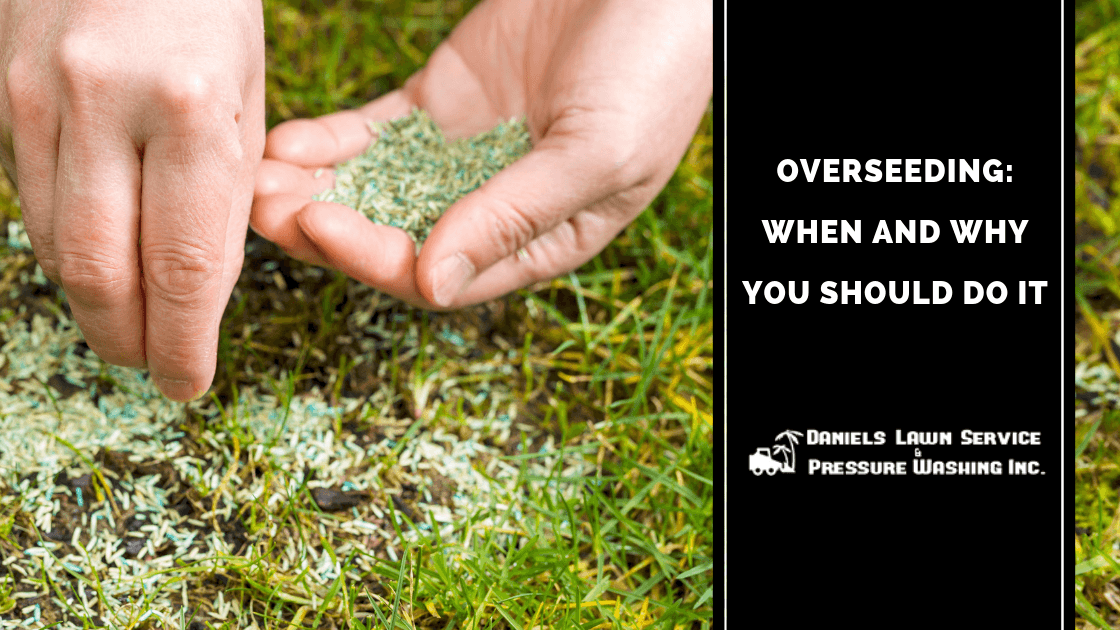

As with any living plant, grass requires continuous care to maintain its appearance and health. Although being quite resilient, grass can die for a number of reasons, even age. Overseeding can combat this issue, as it slowly replaces outdated grass seeds with new ones. Learn why and when you should overseed your Central Florida yard to enjoy a bright and lush lawn for years to come.
What is Overseeding?
Overseeding is a method used to improve existing turf, without removing it or the soil. It is used to treat bare spots, enhance the density of the turf and boost its color. How can you tell if your lawn is a good candidate? If it appears ‘worn out,’ requires copious water and fertilizer to survive or has become susceptible to weeds and insects, it will likely benefit.
Although overseeding is extremely effective, you should first thoroughly inspect and address any other issues plaguing your lawn. Otherwise, you risk undoing all of the work you put into overseeding. If not corrected, a lawn can still deteriorate for any of the following reasons:
- Improper drainage or compact soil
- Lack of water or fertilizer
- Lack of breathability
- Poor sunlight
- Insect or weed infestation
- Improper maintenance
The Benefits of Overseeding
 Overseeding primarily benefits your lawn by introducing new varieties of grass. Older lawns typically contain grass that was common at the time of seeding, and are of lesser quality that those available today. This means they often require more upkeep, and are prone to disease and insects, versus newer varieties of seed. By introducing new seed, you are also less likely to notice patches, when the old seed eventually dies. It will even have less trouble competing with weeds and other environmental factors. Overall, you can expect an easier to maintain lawn.
Overseeding primarily benefits your lawn by introducing new varieties of grass. Older lawns typically contain grass that was common at the time of seeding, and are of lesser quality that those available today. This means they often require more upkeep, and are prone to disease and insects, versus newer varieties of seed. By introducing new seed, you are also less likely to notice patches, when the old seed eventually dies. It will even have less trouble competing with weeds and other environmental factors. Overall, you can expect an easier to maintain lawn.
Why Fall is the Best Time to Overseed the Lawn
Once you have determined that your lawn will benefit from overseeding, when should you do it? The best time of year is during the fall, when weather is ideal for germination. The cool nights and short days allow the seeds ample time to retain moisture for optimal growth. In the summer, the extreme heat would scorch them, compromising a large portion of seeds. While many would assume that spring is the perfect time, other types of lawn care activities common during the season – such as herbicide application – are not conducive to overseeding.
When you do overseed, it should be completed following lawn aeration. Aeration is necessary, as it puts seeds in direct contact with soil. Be sure to use quality seeds that are appropriate for your climate, and drought-resistant. After sprinkling the seeds, you should water the lawn and apply a fall fertilizer. This will assure that they are washed into the soil, and any plugs from aeration are broken up. Make overseeding a part of your autumn lawn care, and plan to see new sprouts within a few weeks ‒ depending on the weather.
If you have trouble discerning problems with you lawn, and think overseeding could be a solution, call Daniel’s Lawn Service & Pressure Washing. Our team of experts can determine the problem, and help you achieve a lush and healthy lawn again. Contact us today to schedule an appointment.


